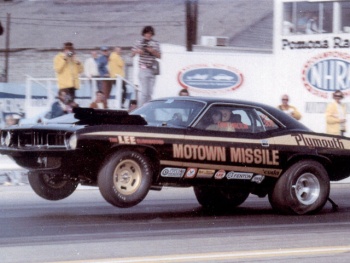Difference between revisions of "Motown Missile"
Old Hippie (talk | contribs) |
|||
| (8 intermediate revisions by 2 users not shown) | |||
| Line 1: | Line 1: | ||
| + | [[Category:Famous Cars]] | ||
| + | [[Category:Race Cars]] | ||
| + | [[Category:Drag Racing]] | ||
| + | {{Template:Openx}} | ||
| + | [[Image:MotownMissle.jpg|thumb|350px|Motown Missile Challenger]] | ||
| + | == Intro == | ||
{{Template:Underconstruction}} | {{Template:Underconstruction}} | ||
| − | == | + | The Motown Missile (the name changed to the Mopar Missile for the 72 [[Cuda]]) originally a 1970 [[Dodge]] [[Challenger]] that [[Chrysler]] had the [[Ram Chargers]] build as a test bed for the new [[Pro Stock]] class of the [[NHRA]]. New ideas were tied and the better ideas were passed along to the other [[Chrysler Sponsored Drivers]]. |
| + | |||
| + | == Drivers == | ||
| + | |||
| + | * [[Dick Oldfield]] was the first driver of the Motown Missile. He also worked on the [[transmissions]] and rear chassis. Oldfield, originally from Buffalo, New York, had previously driven a Chrysler sponsored 64 [[Hemi]] Dodge in [[Super Stock]] called the [[Iron Butterfly]], which was made famous from a horrific transmission explosion at the [[US Nationals]] in 1969. | ||
| + | * [[Akron Arlen Vanke]] | ||
| + | |||
| + | == Crew == | ||
| + | |||
| + | == Cars == | ||
| + | |||
| + | === 70/71 Challenger === | ||
| + | |||
| + | The first of the Motown Missiles was a 1970 Dodge Challenger. It was updated to a 1971 in 71 with replacement of the front and rear panels and [[tail lights]]. One of the more famous items tested was the [[Clutchflite]], which was basically and [[automatic transmission]] using a heavy flywheel and a [[clutch]] (instead of a [[torque converter]]) to launch. They're were deemed to not be reliable and a 4-speed replaced it. Another one of the less successful items tested was to lighten the [[rear axle housing]] by [[acid dipping]], [[Swiss Cheese Drill]] it, and use [[freeze plugs]] to plug the holes. | ||
| + | |||
| + | === 72 Cuda === | ||
| + | |||
| + | === 73 [[Duster]] === | ||
| + | |||
| + | == Sponsors == | ||
| + | |||
| + | * [[Jegs]] | ||
== References == | == References == | ||
| + | |||
| + | * [[Mopar Action Magazine]] October 2010 pgs 10-15 | ||
| + | * [http://www.competitionplus.com/2005_10/missile.html Competition Plus.com] | ||
== Related Links == | == Related Links == | ||
| − | + | {{Template:Referencesneeded}} | |
Latest revision as of 00:11, 1 October 2013
Contents
Intro
This Wiki is Under Construction, and can use your help!
Please take a moment to add any information you might have on this topic. It is through this type of Member collaboration that the MoparWiki will grow into being the Ultimate Mopar Infobase. The links contained in the Understanding Wikis box in the sidebar can help you get started.
The Motown Missile (the name changed to the Mopar Missile for the 72 Cuda) originally a 1970 Dodge Challenger that Chrysler had the Ram Chargers build as a test bed for the new Pro Stock class of the NHRA. New ideas were tied and the better ideas were passed along to the other Chrysler Sponsored Drivers.
Drivers
- Dick Oldfield was the first driver of the Motown Missile. He also worked on the transmissions and rear chassis. Oldfield, originally from Buffalo, New York, had previously driven a Chrysler sponsored 64 Hemi Dodge in Super Stock called the Iron Butterfly, which was made famous from a horrific transmission explosion at the US Nationals in 1969.
- Akron Arlen Vanke
Crew
Cars
70/71 Challenger
The first of the Motown Missiles was a 1970 Dodge Challenger. It was updated to a 1971 in 71 with replacement of the front and rear panels and tail lights. One of the more famous items tested was the Clutchflite, which was basically and automatic transmission using a heavy flywheel and a clutch (instead of a torque converter) to launch. They're were deemed to not be reliable and a 4-speed replaced it. Another one of the less successful items tested was to lighten the rear axle housing by acid dipping, Swiss Cheese Drill it, and use freeze plugs to plug the holes.
72 Cuda
73 Duster
Sponsors
References
- Mopar Action Magazine October 2010 pgs 10-15
- Competition Plus.com
Related Links
This Wiki requires References
The information in this wiki will have more creditability with some references to back it up
